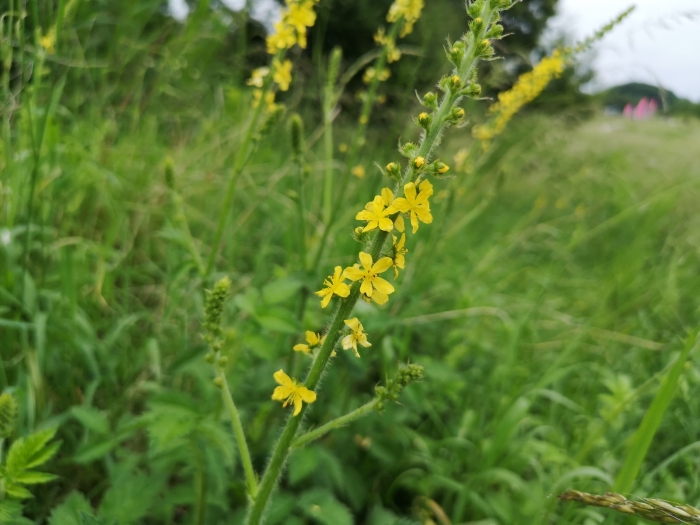Common Agrimony
(Agrimonia eupatoria)
Common Agrimony (Agrimonia eupatoria)
/
/

© Jens-Christian Svenning
CC BY 4.0
Image By:
© Jens-Christian Svenning
Recorded By:
Copyright:
CC BY 4.0
Copyright Notice:
Photo by: © Jens-Christian Svenning | License Type: CC BY 4.0 | License URL: http://creativecommons.org/licenses/by/4.0/ | Uploader: jcsvenning | Publisher: iNaturalist |

























Estimated Native Range
Summary
Agrimonia eupatoria, commonly known as common agrimony, is a deciduous perennial herb native to a variety of habitats including grasslands, woodlands, and forest clearings across Europe to Afghanistan and North Africa. It can grow up to 39 inches (1 meter) tall and features pinnate leaves with serrated margins. From June to September, it produces spike-like inflorescences of small, yellow, five-petaled flowers that are moderately showy. The flowers are followed by distinctive, bur-like seed capsules that can attach to animals for dispersal.
Common agrimony is valued for its astringent properties and has been used in traditional medicine to treat various ailments. Its flowers are attractive to pollinators such as hoverflies, flies, and honey bees, making it beneficial for supporting local ecosystems. In cultivation, agrimony prefers full sun to partial shade, moist but well-drained soils, and is relatively low-maintenance. It is often used in wildflower meadows, herbal gardens, and as a component in naturalistic plantings. While generally disease-free, it can be susceptible to rust and powdery mildew in humid conditions. Agrimony is not known for being invasive but can self-seed readily in conducive environments.CC BY-SA 4.0
Common agrimony is valued for its astringent properties and has been used in traditional medicine to treat various ailments. Its flowers are attractive to pollinators such as hoverflies, flies, and honey bees, making it beneficial for supporting local ecosystems. In cultivation, agrimony prefers full sun to partial shade, moist but well-drained soils, and is relatively low-maintenance. It is often used in wildflower meadows, herbal gardens, and as a component in naturalistic plantings. While generally disease-free, it can be susceptible to rust and powdery mildew in humid conditions. Agrimony is not known for being invasive but can self-seed readily in conducive environments.CC BY-SA 4.0
Plant Description
- Plant Type: Herb
- Height: 2-3 feet
- Width: 1-2 feet
- Growth Rate: Slow, Moderate
- Flower Color: Yellow
- Flowering Season: Spring, Summer
- Leaf Retention: Deciduous
Growth Requirements
- Sun: Full Sun
- Water: Medium
- Drainage: Fast, Medium, Slow
Common Uses
Bee Garden, Butterfly Garden, Edible*Disclaimer: Easyscape's listed plant edibility is for informational use. Always verify the safety and proper identification of any plant before consumption., Low Maintenance
Natural Habitat
native to a variety of habitats including grasslands, woodlands, and forest clearings across Europe to Afghanistan and North Africa
Other Names
Common Names: Common Agrimony, Stickwort, Churchsteeples
Scientific Names: , Agrimonia eupatoria, Agrimonia eupatoria var. grandis, Agrimonia soropia,
GBIF Accepted Name: